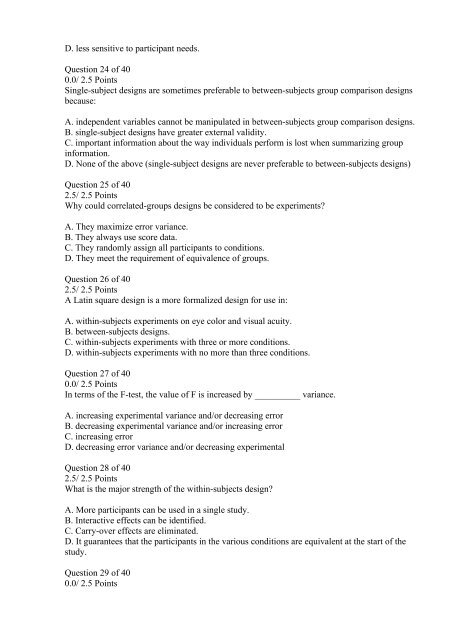PS370 Research Methods in Psychology Online Exam 7 Answers (Ashworth College)
You also want an ePaper? Increase the reach of your titles
YUMPU automatically turns print PDFs into web optimized ePapers that Google loves.
D. less sensitive to participant needs.<br />
Question 24 of 40<br />
0.0/ 2.5 Po<strong>in</strong>ts<br />
S<strong>in</strong>gle-subject designs are sometimes preferable to between-subjects group comparison designs<br />
because:<br />
A. <strong>in</strong>dependent variables cannot be manipulated <strong>in</strong> between-subjects group comparison designs.<br />
B. s<strong>in</strong>gle-subject designs have greater external validity.<br />
C. important <strong>in</strong>formation about the way <strong>in</strong>dividuals perform is lost when summariz<strong>in</strong>g group<br />
<strong>in</strong>formation.<br />
D. None of the above (s<strong>in</strong>gle-subject designs are never preferable to between-subjects designs)<br />
Question 25 of 40<br />
2.5/ 2.5 Po<strong>in</strong>ts<br />
Why could correlated-groups designs be considered to be experiments?<br />
A. They maximize error variance.<br />
B. They always use score data.<br />
C. They randomly assign all participants to conditions.<br />
D. They meet the requirement of equivalence of groups.<br />
Question 26 of 40<br />
2.5/ 2.5 Po<strong>in</strong>ts<br />
A Lat<strong>in</strong> square design is a more formalized design for use <strong>in</strong>:<br />
A. with<strong>in</strong>-subjects experiments on eye color and visual acuity.<br />
B. between-subjects designs.<br />
C. with<strong>in</strong>-subjects experiments with three or more conditions.<br />
D. with<strong>in</strong>-subjects experiments with no more than three conditions.<br />
Question 27 of 40<br />
0.0/ 2.5 Po<strong>in</strong>ts<br />
In terms of the F-test, the value of F is <strong>in</strong>creased by __________ variance.<br />
A. <strong>in</strong>creas<strong>in</strong>g experimental variance and/or decreas<strong>in</strong>g error<br />
B. decreas<strong>in</strong>g experimental variance and/or <strong>in</strong>creas<strong>in</strong>g error<br />
C. <strong>in</strong>creas<strong>in</strong>g error<br />
D. decreas<strong>in</strong>g error variance and/or decreas<strong>in</strong>g experimental<br />
Question 28 of 40<br />
2.5/ 2.5 Po<strong>in</strong>ts<br />
What is the major strength of the with<strong>in</strong>-subjects design?<br />
A. More participants can be used <strong>in</strong> a s<strong>in</strong>gle study.<br />
B. Interactive effects can be identified.<br />
C. Carry-over effects are elim<strong>in</strong>ated.<br />
D. It guarantees that the participants <strong>in</strong> the various conditions are equivalent at the start of the<br />
study.<br />
Question 29 of 40<br />
0.0/ 2.5 Po<strong>in</strong>ts

















